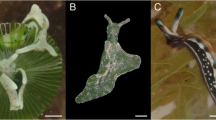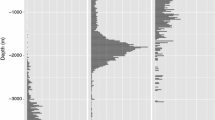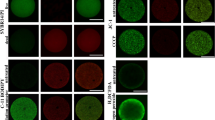Abstract
Although natural exposure to ambient UV radiation in oligotrophic seawater at small depths can reach the levels responsible for cellular damage, the sea urchin Paracentrotus lividus is frequently in such sites, particularly on the southern Adriatic Sea shore. Spawning their eggs and spending their early life stage in rocky shores at depths of 0.5–2 m are the results of their successful adaptation strategies, although adults may dwell at greater depths. Surprisingly, there is a paucity of reports regarding the carotenoid content in sea urchin eggs. Beyond their important role in photoprotection against high UV exposure, cell division and early development, the content and distribution of carotenoids contribute to the successful survival of sea urchins and also determine the color of their gonads (roe), which is of commercial importance as a delicacy. Herein, for the first time, we have described the carotenoid content and distribution in intact, freshly released eggs of P. lividus species, non-destructively employing resonance Raman spectroscopy and imaging; near-infrared Raman spectroscopy revealed additional molecular carotenoid content. Echinenone and β-carotene resonance Raman signals were the most intense, and they were identified as the principal carotenoids that are preferentially accumulated in eggs rather than in gonads. Raman imaging in confocal mode revealed the uniform distribution of the carotenoid signal over the whole eggs, while the distribution of proteins appeared spotted. Egg carotenoids generally maintained their identity after 2 months of dry storage, with slight signs of CvC bond oxidation. The potential utilization of P. lividus sea urchin eggs as valuable microsphere packages of native carotenoids is discussed.
Similar content being viewed by others
References
C. E. Boudouresque and M. Verlaque, Dev Aquacult Fish Sci, in Sea urchins: biology and ecology, ed. J. M. Lawrence, 3rd edn, 2013., vol. 38, ch. 21: Paracentrotus lividus, pp. 297–327.
M. Shumskaya and E. Wurtzel, The carotenoid biosynthetic pathway: thinking in all dimensions, Plant Sci., 2013, 208, 58–63.
M. C. Symonds, M. S. Kelly, C. Caris-Veyrat and A. J. Young, Carotenoids in the sea urchin Paracentrotus lividus: occurence of 9′-cis-echinenone as the dominant carotenoid in gonad colour determination, Comp. Biochem. Physiol., Part B: Biochem. Mol. Biol., 2007, 148, 432–444.
M. Shpigel, S. C. Schlosser, A. Ben-Amotz, A. L. Lawrence and J. M. Lawrence, Effects of dietary carotenoid on the gut and the gonad of sea urchin Paracentrotus lividus, Aquacult, 2006, 261, 1269–1280.
A. R. de Quirós, J. López-Hernández and J. Simal-Lozano, Determination of carotenoids and liposoluble vitamins in sea urchin (Paracentrotus lividus) by high performance liquid chromatography, Eur. Food Res. Technol., 2001, 212, 687–690.
M. Shpigel, S. C. McBride, S. Marciano, S. Ron and A. Ben-Amotz, Improving gonad colour and somatic index in the European sea urchin Paracentrotus lividus, Aquaculture, 2005, 245, 101–109.
M. Griffiths and P. Perrott, Seasonal changes in the carotenoids of the sea urchin Strongylocentrotus dröbachiensis, Comp. Biochem. Physiol., B: Comp. Biochem., 1976, 55, 435–441.
D. Garama, P. Bremer and A. Carne, Extraction and analysis of carotenoids from the New Zealand sea urchin Evechinus chloroticus gonads, Acta Biochim. Pol., 2012, 59, 83–85.
R. C. Symonds, M. S. Kelly, C. C. Suckling and A. J. Young, Carotenoids in the gonad and gut of the edible sea urchin Psammechinus miliaris, Aquacult, 2009, 288, 120–125.
F. Nekvapil, I. Brazeştean, S. Tomšić and S. Cintă Pinzaru, Comparative Raman spectroscopy study of the coelomic fluid of grazing sea urchins and their native seawater: prospect for a potential indicator of environmental aggression, in Air and water components of the environment, ed. G. Şerban, R. Bătinaş, T. Tudose, C. Horváth, A. Croitoru and I. Holobâcă, University Press, Cluj-Napoca, 2018, pp. 27–34.
J. Pilbrow, M. Sabherwal, D. Garama and A. Carne, A novel fatty acid-binding protein-like carotenoid-binding protein from the gonad of the New Zealand sea urchin Evechinus chloroticus, PLoS One, 2015, 9, e106465.
M. di Bernardo and M. di Carlo, The sea urchin embryo: a model for studying molecular mechanisms involved in human diseases and for testing bioactive compounds, in Sea Urchin, ed. H. Agnello, InTech, London, 2017, ch. 6, pp. 119–144.
K. Osanai, Behavior, of pigment granules during early development in the eggs of a sea urchin, Temnopleurus hardwickii, Ann. Rep. Fac. Educ., Univ. Iwate, 1969, 29, 35–39.
G. Czihak, The sea urchin embryo - Biochemistry and Morphogenesis, Springer-Verlag Berlin, Geidelberg, Bew York, 1975.
M. de Nicola and T. W. Godwin, Carotenoids in the developing eggs of the sea urchin Paracentrotus lividus, Exp. Cell Res., 1954, 7, 23–31.
M. Fernández-Boán, L. Fernández and J. Freire, History and management strategies of the sea urchin Paracentrotus lividus fishery in Galicia (NW Spain), Ocean Coast Manage, 2012, 69, 265–272.
S. Cintă Pinzaru, C. Müller, S. Tomšić, M. M. Venter, B. I. Cozar and B. Glamuzina, New SERS feature of β-carotene: consequences for quantitative SERS analysis, J. Raman Spectrosc., 2015, 46, 597–604.
J. C. Merlin, Resonance Raman spectroscopy of carotenoids and carotenoid-containing systems, Pure Appl. Chem., 1985, 57, 785–792.
N. Tschirner, M. Schenderlein, K. Brose, E. Schledder, M. A. Mroginski, C. Thomson and P. Hildevrandt, Resonance Raman spectra of beta-carotene in solution and in photosystems revisited: an experimental and theoretical study, Phys. Chem. Chem. Phys., 2009, 11, 11471–11478.
M. Macernis, J. Sulskus, S. Malickaja, B. Robert and L. Valkunas, Resonance Raman spectra and electronic transitions in carotenoids: a Density functional theory study, J. Phys. Chem. A, 2014, 118, 1817–1825.
M. J. Liansola-Portoles, A. A. Pascal and B. Robert, Electronic and vibrational properties of carotenoids: from in vitro to in vivo, J. R. Soc., Interface, 2017, 14, 20170504.
H. Schulz, M. Baranska and R. Baranski, Potential of NIR-FT-Raman spectroscopy in natural carotenoid analysis, Biopolymers, 2005, 77, 212–221.
V. E. de Oliveira, H. V. Castro, H. J. M. Edwards and L. F. C. de Oliveira, Carotenes and carotenoids in natural biological samples: a Raman spectroscopic analysis, J. Raman Spectrosc., 2010, 41, 642–650.
E. Kish, M. M. Mendes Pinto, D. Kirilovsky, R. Spezia and B. Robert, Echinenone vibrational properties: from solvents to the orange carotenoid protein, Biochim. Biophys. Acta, 2015, 1847, 1044–1054.
F. Nekvapil, I. Brezeştean, D. Barchewitz, B. Glamuzina, V. Chiş and S. Cintă Pinzaru, Citrus fruits freshenss assessment using Raman spectroscopy, Food Chem., 2018, 242, 560–567.
W.-W. Feng, W. Zhang, X.-X. Tian, H.-L. Peng, H. Xiong and L.-X. Chen, A portable spectrum measurement system based on laser-Raman and fluoresce spectrum for cooking oil analysis, Adv. Mater. Res., 2012, 588–589, 1152–1155.
M. Sourdaine, D. Guenther, A.-M. Dowgiallo, C. Harvey, Y. Mattley, A. Guckian and O. Lischtschenko, Protecting the food supply chain: utilizing SERS and portable Raman spectroscopy, Tech. Mess., 2015, 82, 625–632.
R. Gillibert, J. Q. Huang, Y. Zhang, W. L. Fu and M. L. de la Chapelle, Food quality control by Surface enhanced Raman scattering, Trends Anal. Chem., 2018, 105, 185–190.
M. D. Lamare and J. Hoffman, Natural variation of carotenoids in the eggs and gonads of the echinoid genus, Strongylocentrotus: implications for their role in ultraviolet radiation photoprotection, J. Exp. Mar. Biol. Ecol., 2004, 312, 215–233.
A. C. Giese, The effects of ultra-violet radiations of various wave-lengths upon cleavage of sea urchin eggs, Biol. Bull., 1938, 75, 238–247.
S. Nahon, V. A. Castro Porras, A. M. Pruski and F. Charles, Sensitivity to UV radiation in early life stages of the Mediterranean sea urchin Sphaerechinus granularis (Lamarck), Sci. Total Environ., 2009, 407, 1892–1900.
S. Tomšić, C. Alexis, I. Dupčić Radić and B. Glamuzina, Growth, size class frequency and reproduction of purple sea urchin, Paracentrotus lividus (Lamarck, 1816) in Bistrina Bay (Adriatic Sea, Croatia), Acta Adriat., 2010, 51, 67–77.
M. Tsushima, T. Kawakami, M. Mine and T. Matsuno, The role of carotenoids in the development of the sea urchin Pseudocentrotus depressus, Invertebr. Reprod. Dev., 1997, 32, 149–153.
C. Pénicaud, N. Achir, C. Dhuique-Mayer, M. Dornier and P. Bohuon, Degradation of β-carotene during fruit and vegetable processing or storage: Reaction mechanisms and kinetic aspects: A review, Fruits, 2011, 66, 417–440.
K. Czamara, K. Majzner, M. Z. Pacia, K. Kochan, A. Kaczor and M. Baranska, Raman spectroscopy of lipids: a review, J. Raman Spectrosc., 2014, 46, 4–20.
A. Rygula, K. Majzner, K. M. Marzec, A. Kaczor, M. Pilarczyk and M. Baranska, Raman spectroscopy of proteins: a review, J. Raman Spectrosc., 2013, 44, 1061–1076.
M. Ishigaki, A. Taketani and H. Sato, Discrimination of fish egg quality and viability by Raman spectroscopy, Anal. Methods, 2014, 6, 9206–9211.
M. Griffiths, The carotenoids of the eggs and embryos of the sea urchin Strongylocentrotus purpuratus, Dev. Biol., 1966, 13, 296–309.
F. Nekvapil, Quantification of carotenoids in the stony sea urchin Paracentrotus lividus Lamarck 1816, Dissertation, University of Dubrovnik, 2017. https://repozitorij.unidu.hr/islandora/object/unidu:280/preview. Acessed October 30, 2018.
J. A. Timlin, A. M. Collins, T. A. Beechem, M. Shumskaya and E. T. Wurtzel, Localizing and quantifying carotenoids in intact cells and tissues, in Carotenoids, ed. D. Cvetkovic, InTech, London, 2017, ch. 3, pp. 35–50.
S. Takaichi, M. Mochimaru, T. Maoka and H. Katoh, Myxol and 4-ketomyxol 2′-fucosides, not rhamnosides, from Anabaena sp. PCC 7120 and Nostoc punctiforme PCC 73102, and proposal for the biosynthetic pathway of carotenoids, Plant Cell Physiol., 2005, 46, 497–504.
D.-P. Häder, C. E. Williamson, S.-A. Wängberg, M. Rautio, K. C. Rose, K. Gao, E. W. Helbling, B. P. Sinhah and R. Worresti, Effects of UV radiation on aquatic ecosystems and interactions with other environmental factors, Photochem. Photobiol. Res., 2015, 14, 108–126.
M. Tsuchiya, G. Scita, H.-J. Freisleben, V. E. Kagan and L. Packer, Antioxidant radical-scavenging activity of carotenoids and retinoids compared to a-tocopherol, Methods Enzymol., 1992, 213, 460–472.
G. T. Wondrak, M. K. Jacobson and E. L. Jacobson, Endogenous UVA-photosensitizers: mediators of skin photodamage and novel targets for skin photoprotection, Photochem. Photobiol. Sci., 2006, 5, 215–237.
T. Grune, G. Lietz, A. Palou, A. C. Ross, W. Stahl, G. Tang, D. Thurnham, S. Yin and H. K. Biesalski, β-carotene Is an important vitamin A source for humans, J. Nutr., 2010, 140, 2268S–2285S.
O. Luis, F. Delgado and J. Gago, Year-round captive spawning performance of the sea urchin Paracentrotus lividus: Relevance for the use of its larvae as live feed, Aquat. Living Resour., 2005, 18, 45–54.
J. Gago and O. Luis, Comparison of spawning induction techniques on Paracentrotus lividus (Echinodermata: Echinoidea) broodstock, Aquacult. Int., 2011, 19, 181–191.
Author information
Authors and Affiliations
Corresponding author
Additional information
Electronic supplementary information (ESI) available. See DOI: 10.1039/c9pp00181f
Rights and permissions
About this article
Cite this article
Nekvapil, F., Brezeştean, I., Tomšić, S. et al. Microsphere packages of carotenoids: intact sea urchin eggs tracked by Raman spectroscopy tools. Photochem Photobiol Sci 18, 1933–1944 (2019). https://doi.org/10.1039/c9pp00181f
Received:
Accepted:
Published:
Issue Date:
DOI: https://doi.org/10.1039/c9pp00181f




